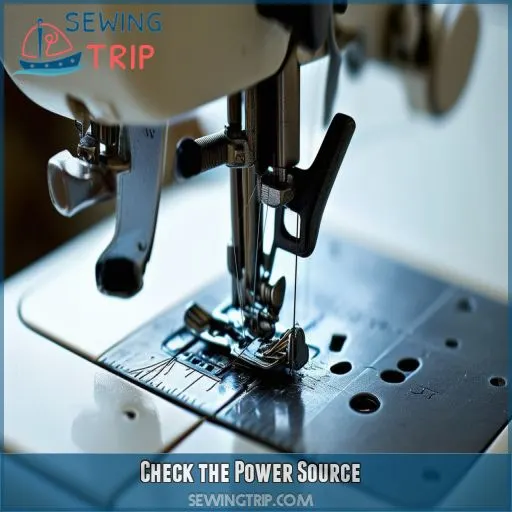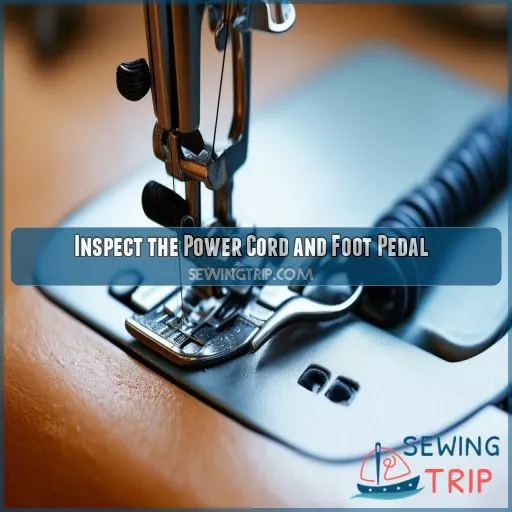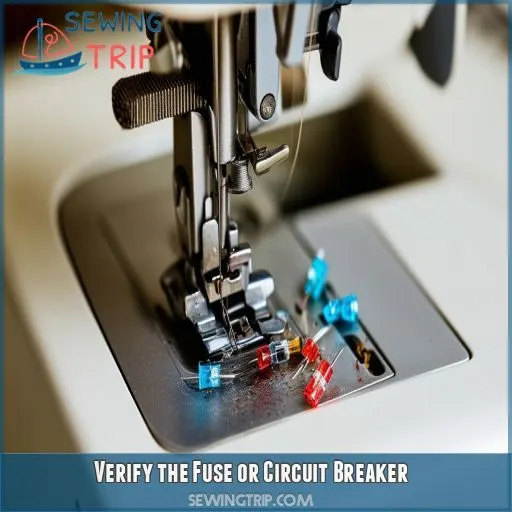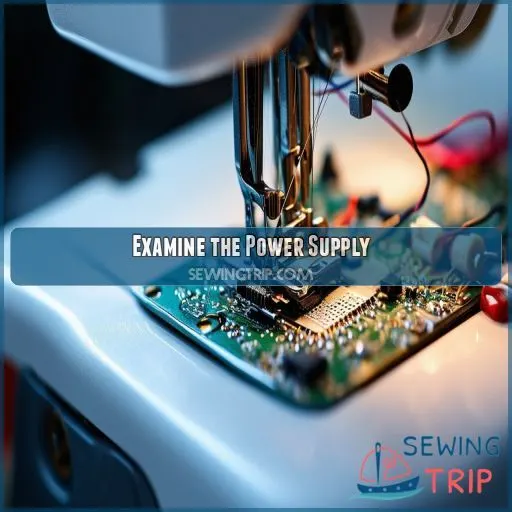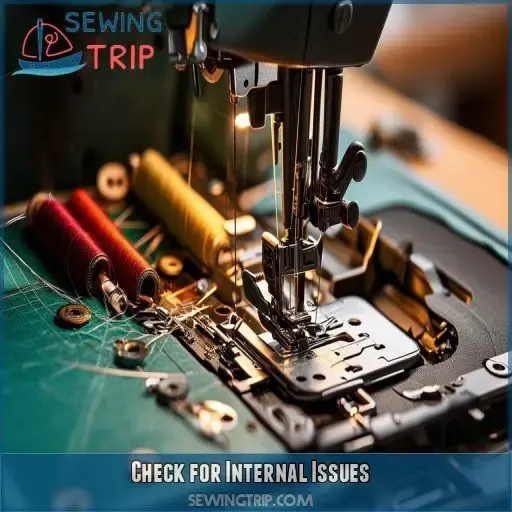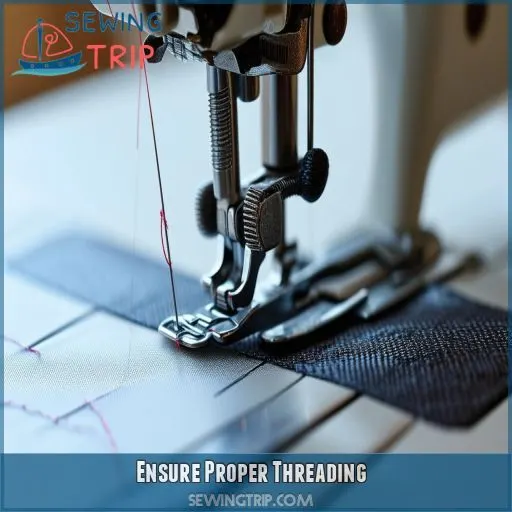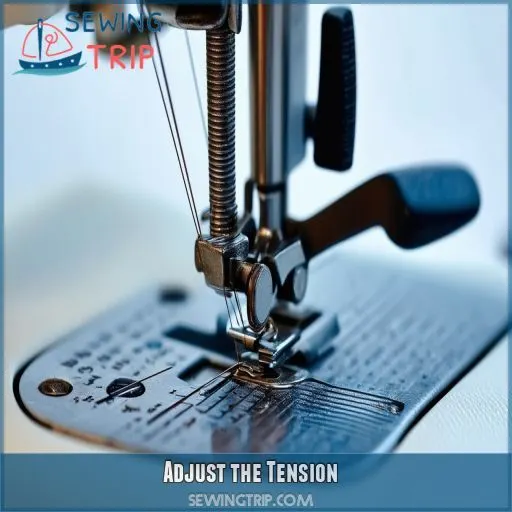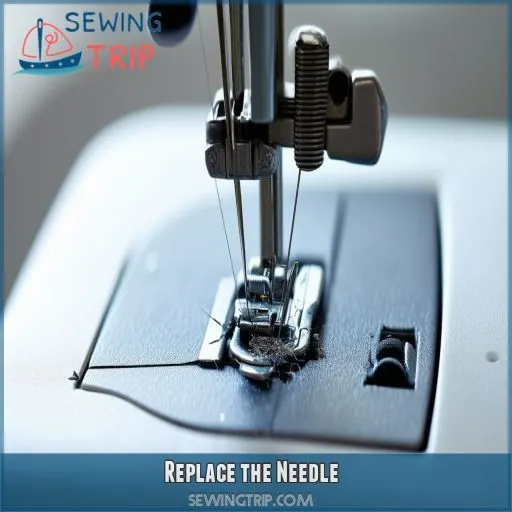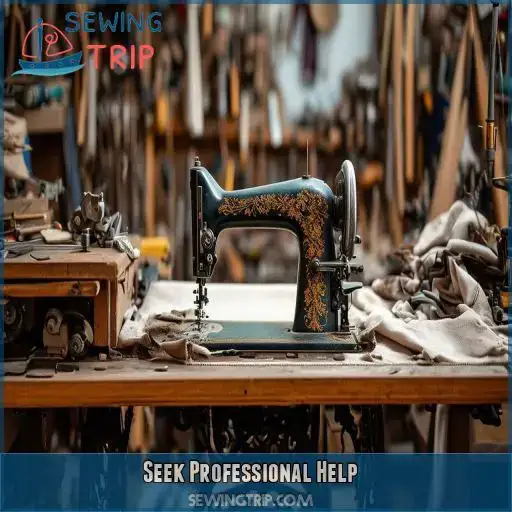This site is supported by our readers. We may earn a commission, at no cost to you, if you purchase through links.
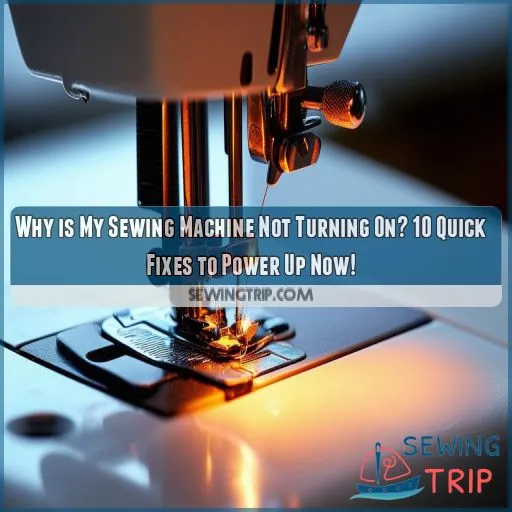
Never fear, though – there are a few quick fixes you can try before bringing in the pros. From source-of-power checking to interior component surveys, this guide will walk you through 10 practical solutions to get your sewing machine humming once more.
Let’s do some troubleshooting for you to return to your projects quickly.
Table Of Contents
- Key Takeaways
- Why is My Sewing Machine Not Turning On?
- Check the Power Source
- Inspect the Power Cord and Foot Pedal
- Verify the Fuse or Circuit Breaker
- Examine the Power Supply
- Check for Internal Issues
- Ensure Proper Threading
- Clean and Oil the Machine
- Adjust the Tension
- Replace the Needle
- Seek Professional Help
- Frequently Asked Questions (FAQs)
- Conclusion
Key Takeaways
- Don’t let a silent sewing machine needle you – there are plenty of quick fixes to try before calling in the pros! Start with the basics like checking power sources and connections. You’d be surprised how often a loose plug is the culprit.
- Sometimes it’s the little things that trip us up. A faulty foot pedal or blown fuse can bring your creative plans to a screeching halt. Give these often-overlooked components a once-over before assuming the worst.
- Your sewing machine might just need a little TLC. Regular cleaning and oiling can work wonders, turning a stubborn machine into a purring powerhouse. It’s like a day at the spa for your faithful stitching companion!
- When all else fails, don’t be afraid to call in the cavalry. Professional repair services have the tools and know-how to diagnose tricky issues.
Why is My Sewing Machine Not Turning On?
If your sewing machine’s not turning on, don’t panic!
First, check the basics: Is the power switch on? Is the cord plugged in securely? Test the outlet with another appliance to rule out electrical issues. Inspect the power cord and foot pedal for damage.
If these check out, look at the fuse or circuit breaker. Internal problems like loose connections or frayed wires could be culprits too. Sometimes, incorrect threading can prevent startup.
Clean and oil your machine regularly to keep it running smoothly.
If you’ve tried these steps and it’s still lifeless, it might be time for a professional diagnosis. There’s more to uncover about bringing your trusty stitching companion back to life.
Check the Power Source
First, check that the sewing machine’s power switch is on. Then, ensure that the power cord fits tightly both in the sewing machine and in the wall outlet. If everything seems okay, test for power at the wall outlet with another appliance.
Ensure the Power Switch is in the on Position
First, see if the power switch of the sewing machine is on. Sometimes, owing to a power surge or voltage fluctuations, this switch trips. See that it’s turned to the "on" position. If the switch feels loose or faulty, it must be replaced. The machine won’t turn on if there’s faulty wiring.
Check if the Power Cord is Plugged in Securely
First, check that your sewing machine’s power cord is firmly pushed into the machine and the wall outlet. If this connection is loose, it may prevent your machine from coming on. Make sure:
- The power cord is plugged fully into the power socket of the machine.
- The plug is firmly seated within the wall outlet or surge protector.
• No signs of damage to the cord or electrical connections are evident.
Test the Wall Outlet With Another Appliance
If your sewing machine still isn’t powering up, it’s time to test the outlet itself. Grab a small appliance you know works, like a lamp or phone charger. Plug it into the same outlet and see if it turns on. This simple test can quickly reveal if the problem lies with your outlet or your sewing machine.
Inspect the Power Cord and Foot Pedal
First, ensure that the pedal is well connected. If your sewing machine can’t turn on, possibly the simplest thing that one can check would be that its foot pedal is securely connected. Next, check if there’s a loose wire in the foot control or the power lead because this may dam the power flow. Provided the pedal is firmly seated, but still it doesn’t turn on, look for any visible damage to the power cord or any fraying. A damaged cord is likely to interrupt the electrical supply and call for a replacement.
Now check the continuity of the foot pedal itself. A faulty foot pedal could be the issue related to your power problem. The machine doesn’t come on when one presses the pedal because sometimes there’s a tripped foot control power lead or internal damage inside the pedal. Other times, either the variable resistor or the internal drive gears have gone wrong in the pedal itself. If you’re unsure, refer to your sewing machine manual or seek professional assistance in sewing machine repairs to diagnose or repair the problem.
Verify the Fuse or Circuit Breaker
If your sewing machine still won’t turn on after checking the power cord and foot pedal, it’s time to verify the fuse or circuit breaker. These components protect your machine from electrical surges but can sometimes be the culprit behind power issues.
First, locate the fuse in your sewing machine. It’s usually near the power inlet or in a small compartment. Check if it’s blown using a multimeter or circuit tester. If it is, replace it with a new fuse of the same amperage. Be sure to use the correct fuse type to avoid damaging your machine.
If your machine uses a circuit breaker instead, look for a small reset button. If it’s popped out, simply push it back in. This might restore power to your machine.
Examine the Power Supply
If your sewing machine still won’t turn on, it’s time to look at the power supply. First, check the power cable’s condition for visible wear and breaks. A compromised cable just pipes electricity to your machine. Next, check the foot control connection—ensure this is firmly pushed into the socket on the machine.
The problem could, therefore be within the internal circuit board in the case of computerized machines. These are mostly reliable, though a faulty board can cause power problems. If you’re comfortable, open the machine and look for any signs of burnt components or loose connections on the circuit board.
Also, don’t forget to check the drive motor. A malfunctioning motor won’t turn the handwheel or upper shaft even if it has power. Observe any unusual sounds when trying to start up.
If you’ve ruled out these issues, it’s time to consider internal wiring problems or a faulty on/off switch.
Check for Internal Issues
If you’ve checked the power source and connections, it’s time to look inside your sewing machine. Internal issues can be tricky, but don’t worry – we’ll tackle them together.
First, unplug your machine and remove the cover. Check for any loose connections or frayed wires. A faulty PCB or blown capacitor could be the culprit, so inspect these components carefully.
Listen for any unusual noises when you turn the handwheel – this could indicate a mechanical problem. If you notice your machine jamming frequently, it might be due to internal issues like a misaligned timing belt.
Regular maintenance is key to preventing these problems. Clean your machine thoroughly, removing lint and debris from hard-to-reach areas.
If you’re not comfortable poking around inside, it’s best to consult a professional. They can diagnose and fix complex internal issues, ensuring your machine runs smoothly for years to come.
Ensure Proper Threading
While it may seem unrelated, incorrect threading can actually prevent your sewing machine from turning on. Check that your machine is threaded properly, following the manufacturer’s guidelines, as this can resolve power-related issues in some cases.
Incorrect Threading Can Cause the Machine to Malfunction
You might be surprised to learn that incorrect threading can wreak havoc on your sewing machine’s performance. Even if the power’s on, improper threading can lead to a host of issues like bent needles, thread bunching (also known as a "bird’s nest"), and constant thread breaking. These problems often mimic electrical faults, fooling you into thinking your machine’s not turning on.
Don’t let poor thread quality or incorrect tension adjustment throw you off. Bobbin issues can also masquerade as power problems.
Always check your threading before assuming the worst!
Double-check That the Machine is Threaded Correctly
Double-check your machine’s threading to ensure it’s correct. Improper threading can lead to:
- Skipped stitches and bobbin thread bunching
• Thread routing problems that produce a "bird’s nest" effect
Timing problems during the shuttle Race
Check that you’re running the right type and size of needles for your fabric. Wrong needles may cause havoc on the stitching. Additionally, inspect the shuttle race for any bunching of thread or other debris. A well-threaded machine is the key to smooth sewing, minus the frustrating power-on issues.
Clean and Oil the Machine
If it still doesn’t turn on, then it’s time to clean and oil your sewing machine. This is part of the regular maintenance needed to keep it running smoothly. Here’s a quick guide through:
| Area to Clean | Tools Needed | Frequency |
|---|---|---|
| Bobbin Case | Brush, Cloth | Weekly |
| Feed Dogs | Brush, Cloth | Monthly |
| Tension Discs | Brush, Cloth | Monthly |
| Needle Bar | Oil | Monthly |
First of all, remove the plug of your machine and take off the needle plate. Using a small brush, clean up any lint or other remains in the bobbin case and feed the dogs. All the accessible parts should be cleaned with a clean cloth. Apply one drop of sewing machine oil to any moving parts.
Do not forget to lubricate such areas as the needle bar and hook race. This maintenance routine should overcome any internal friction, buildup, or grime. If your machine still won’t turn on after cleaning and oiling, consider professional help.
Adjust the Tension
After cleaning and oiling your machine, it’s time to tackle tension issues. Improper tension can cause a host of problems, from skipped stitches to fabric puckering. If your machine’s still not turning on, tension adjustment mightn’t be the culprit, but it’s worth checking once you’ve got power.
Here’s how to troubleshoot tension problems:
- Start with the default setting (usually 4 or 5) and test on scrap fabric
- Adjust upper tension first, then lower if needed
- Look for balanced stitches on both sides of the fabric
Replace the Needle
If adjusting the tension didn’t fix your power-related problem, it’s time to check your needle. A bowed, faulty, or inappropriate needle could cause your machine to seize and prevent it from turning on. Here’s a short guide to needles and their sizes:
| Type of Needle | Size | Best For | Not Suitable For |
|---|---|---|---|
| Universal | 80/12 | Most fabrics | Heavy denim |
| Ballpoint | 70/10 | Knits | Woven fabrics |
| Stretch | 75 /11 | Lycra, spandex | Leather |
Jeans – 100/16 Denim, canvas Delicate fabrics
First, change your needle to the appropriate type for your fabric. Make sure it’s correctly inserted with the flat side toward the back. If it still doesn’t turn on after doing that, then the needle timing must be off. This probably means you hit a pin or thick seam. Although timing can’t be fixed by you, this is common, and pros can fix it quickly.
Seek Professional Help
If you’ve tried all the previous steps and your sewing machine still won’t turn on, it’s time to seek professional help. Don’t beat yourself up; even the most experienced sewers sometimes need an expert’s touch. Contact a repair service or the manufacturer’s customer support to schedule a checkup. They’ll have the tools and know-how to diagnose and fix complex issues that might be beyond your scope.
When you call for assistance, be prepared to provide details about your machine’s make and model, as well as a description of the problem. This information will help the technician come prepared with the right parts and tools. Remember, attempting to fix electrical issues without proper knowledge can be dangerous and might void your warranty.
While it’s frustrating to have a non-functioning machine, professional repair can often breathe new life into your trusty sewing companion, saving you from the cost of a replacement.
Frequently Asked Questions (FAQs)
Why did my sewing machine suddenly stop working?
Your sewing machine just stops, perhaps due to lack of power or because a fuse has blown or the foot pedal is faulty. Check the power source by making sure that all connections are tight and that the bulb is good. If none of the above works, there could be some internal problems that require professional intervention.
Why is my sewing machine motor not turning?
Your sewing machine motor’s not turning? Check the power source, foot pedal connection, and internal wiring. It could be a faulty motor, locked gears, or electrical issues. If basic troubleshooting fails, you’ll need professional repair.
Why is my sewing machine wheel not turning?
This may be caused by jammed threads in the sewing machine, a locked drive gear, or even a faulty motor. Check for tangled threads in the bobbin area, ensure that the handwheel is disengaged for winding, and test the functionality of the motor itself.
What turns the sewing machine on?
You’ll turn your sewing machine on using the power switch, typically located on the side or back. Make sure it’s plugged in, and the foot pedal’s connected. If it’s still not powering up, check the fuse.
Why is my sewing machine not running smoothly?
Your machine’s not running smoothly? It could be threading issues, tension problems, or a clogged mechanism. Check your thread path, adjust tension settings, and clean out any lint. Regular maintenance keeps things humming along nicely.
Why does my sewing machine not sew?
It won’t sew because the sewing machine may be threaded incorrectly, has a tension problem, or uses a jammed bobbin. Check your needle condition, thread path, and where the bobbin sits. Clean off any built-up lint, and be sure to put down your presser foot before continuing troubleshooting.
Why is my sewing machine not rotating properly?
It’s rather like the rotation problems of the sewing machine, which can be due to several issues by threads caught up in it, lack of lubrication of moving parts, or you have stuck the handwheel. If the problem continues, check for wear or damage on the motor and belt.
Why is my sewing machine locked up?
The sewing machine may lock up from thread bunching inside the shuttle race, causing poor timing in the needle or broken internal gears. Clean off the race; reposition your needle correctly; lubricate properly. If problems persist, consult a technician.
Can a faulty bobbin winder prevent the machine from starting?
Ever wondered if a small part could cause big trouble? A faulty bobbin winder typically won’t prevent your machine from starting. It’s a separate mechanism. Check power connections, foot pedal, and motor issues first for startup problems.
How do I test if the main circuit board is working?
You’ll need specialized equipment to test the main circuit board. Start by visually inspecting for burnt components or loose connections. If you’re not comfortable with electronics, it’s best to consult a professional technician for accurate diagnosis.
Could a jammed presser foot lifter cause power issues?
A jammed presser foot lifter won’t directly cause power issues. It’s a mechanical problem, not electrical. You’ll need to check your power source, connections, and internal components. If everything’s plugged in correctly, consider professional servicing for electrical troubleshooting.
Is machine age a factor in sudden power failures?
Age ain’t nothin’ but a number, but it can impact your sewing machine. Older models are more prone to sudden power failures due to worn components. Regular maintenance helps, but you’ll need to weigh repair costs against replacement.
Can extreme temperature changes affect the machines electrical components?
Yes, extreme temperatures can impact your machine’s electrical components. Cold can cause wiring to contract and break, while heat may expand and damage delicate parts. Keep your machine in a climate-controlled area to prevent these issues.
Conclusion
Did you know that 85% of sewing machine issues can be resolved without professional help? By following these 10 quick fixes, you’ve got a good chance of solving why your sewing machine isn’t turning on.
From checking power sources to inspecting internal components, you’ve now got a toolkit of practical solutions.
If you’ve tried everything and your machine still won’t budge, don’t hesitate to seek expert assistance.

